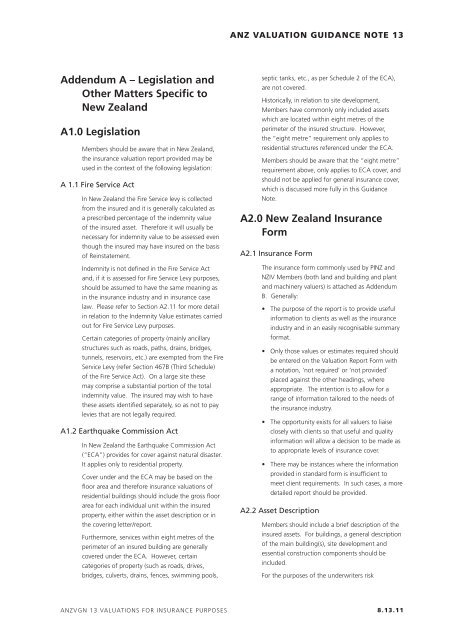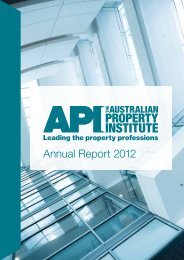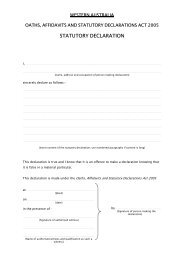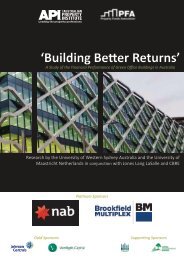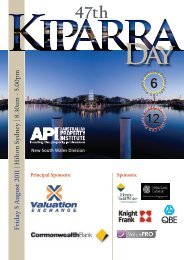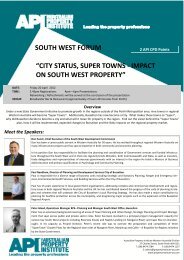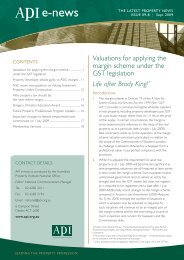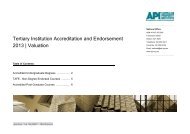VALUATIONS FOR INSURANCE PURPOSES
VALUATIONS FOR INSURANCE PURPOSES
VALUATIONS FOR INSURANCE PURPOSES
Create successful ePaper yourself
Turn your PDF publications into a flip-book with our unique Google optimized e-Paper software.
ANZ VALUATION GUIDANCE NOTE 13<br />
Addendum A – Legislation and<br />
Other Matters Specific to<br />
New Zealand<br />
A1.0 Legislation<br />
Members should be aware that in New Zealand,<br />
the insurance valuation report provided may be<br />
used in the context of the following legislation:<br />
A 1.1 Fire Service Act<br />
In New Zealand the Fire Service levy is collected<br />
from the insured and it is generally calculated as<br />
a prescribed percentage of the indemnity value<br />
of the insured asset. Therefore it will usually be<br />
necessary for indemnity value to be assessed even<br />
though the insured may have insured on the basis<br />
of Reinstatement.<br />
Indemnity is not defined in the Fire Service Act<br />
and, if it is assessed for Fire Service Levy purposes,<br />
should be assumed to have the same meaning as<br />
in the insurance industry and in insurance case<br />
law. Please refer to Section A2.11 for more detail<br />
in relation to the Indemnity Value estimates carried<br />
out for Fire Service Levy purposes.<br />
Certain categories of property (mainly ancillary<br />
structures such as roads, paths, drains, bridges,<br />
tunnels, reservoirs, etc.) are exempted from the Fire<br />
Service Levy (refer Section 467B (Third Schedule)<br />
of the Fire Service Act). On a large site these<br />
may comprise a substantial portion of the total<br />
indemnity value. The insured may wish to have<br />
these assets identified separately, so as not to pay<br />
levies that are not legally required.<br />
A1.2 Earthquake Commission Act<br />
In New Zealand the Earthquake Commission Act<br />
(“ECA”) provides for cover against natural disaster.<br />
It applies only to residential property.<br />
Cover under and the ECA may be based on the<br />
floor area and therefore insurance valuations of<br />
residential buildings should include the gross floor<br />
area for each individual unit within the insured<br />
property, either within the asset description or in<br />
the covering letter/report.<br />
Furthermore, services within eight metres of the<br />
perimeter of an insured building are generally<br />
covered under the ECA. However, certain<br />
categories of property (such as roads, drives,<br />
bridges, culverts, drains, fences, swimming pools,<br />
septic tanks, etc., as per Schedule 2 of the ECA),<br />
are not covered.<br />
Historically, in relation to site development,<br />
Members have commonly only included assets<br />
which are located within eight metres of the<br />
perimeter of the insured structure. However,<br />
the “eight metre” requirement only applies to<br />
residential structures referenced under the ECA.<br />
Members should be aware that the “eight metre”<br />
requirement above, only applies to ECA cover, and<br />
should not be applied for general insurance cover,<br />
which is discussed more fully in this Guidance<br />
Note.<br />
A2.0 New Zealand Insurance<br />
Form<br />
A2.1 Insurance Form<br />
The insurance form commonly used by PINZ and<br />
NZIV Members (both land and building and plant<br />
and machinery valuers) is attached as Addendum<br />
B. Generally:<br />
• The purpose of the report is to provide useful<br />
information to clients as well as the insurance<br />
industry and in an easily recognisable summary<br />
format.<br />
• Only those values or estimates required should<br />
be entered on the Valuation Report Form with<br />
a notation, ‘not required’ or ‘not provided’<br />
placed against the other headings, where<br />
appropriate. The intention is to allow for a<br />
range of information tailored to the needs of<br />
the insurance industry.<br />
• The opportunity exists for all valuers to liaise<br />
closely with clients so that useful and quality<br />
information will allow a decision to be made as<br />
to appropriate levels of insurance cover.<br />
• There may be instances where the information<br />
provided in standard form is insufficient to<br />
meet client requirements. In such cases, a more<br />
detailed report should be provided.<br />
A2.2 Asset Description<br />
Members should include a brief description of the<br />
insured assets. For buildings, a general description<br />
of the main building(s), site development and<br />
essential construction components should be<br />
included.<br />
For the purposes of the underwriters risk<br />
ANZVGN 13 <strong>VALUATIONS</strong> <strong>FOR</strong> <strong>INSURANCE</strong> <strong>PURPOSES</strong><br />
8.13.11


